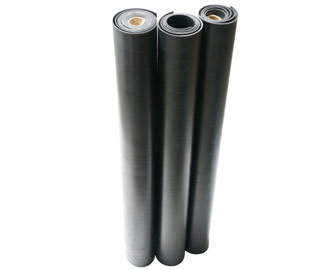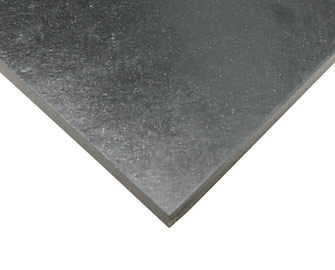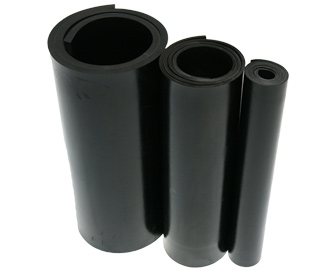|
|
First developed in the early 1930s, neoprene material was the first successful synthetic elastomer to hit the market. With World War II raging, natural rubber materials were becoming scarce which led to the United States’ discovery of chemically engineered neoprene elastomers. This new neoprene material was made with the intention of replacing natural rubber with a stronger and more resilient synthetic rubber. Its unique chemical makeup allows a neoprene rubber sheet to be used in highly abrasive environments that may involve chemicals, oils, and extreme temperatures. However, as time went on, neoprene elastomers’ usage spread worldwide, making it more accessible to other countries. Today, neoprene manufacturers are able to make custom neoprene parts fabricated specifically to the measurements provided by the customer.
Who Invented Neoprene?
Neoprene material, also known as “chloroprene”, was invented by two DuPont chemists, Wallace Carothers and Arnold Collins, in 1930. Originally invented in 1930, neoprene elastomers’ popularity rose during World War II due to the shortage of natural rubber material caused by the war. The neoprene material is dubbed “DuPrene” after the company but was soon changed to “neoprene” in 1937 as a result of the DuPont laboratories’ effort to inform consumers “that the material is an ingredient, not a finished product” (Wikipedia.org). Additionally, a year later in 1938, foam neoprene material was accidentally discovered by Otto Bayer and, in the long run, invented a new way to manufacture neoprene elastomers. By the 1940s, with World War II in play, the demand for neoprene doubles as the natural rubber supply to the United States was cut off by Japan. At the time, synthetic rubbers, including neoprene material, were the only elastomers available to countries who were not allied with Japan. During that time, neoprene material was used as a more durable and resilient alternative to natural rubber. Today, neoprene elastomers are used around the word to replace natural rubber in highly abrasive applications.

|

|
Where is Neoprene Made?
Neoprene material was originally invented and produced in the United States; however, today, it is produced and used worldwide. A neoprene rubber sheet can be used for many different purposes, such as seals and gaskets, with many manufacturers offering custom neoprene cut products. Neoprene manufacturers use various methods, such as die cutting, laser cutting, water jet cutting, and even hand cutting, to provide consumers with custom neoprene parts. Each method of cutting a neoprene rubber sheet determines the precision of each cut. For instance, hand cutting is generally used for less precise cuts because it is not a computer operated method. On the other hand, die, laser, and water jet cutting offers a more precise cut where measurements are entered into a computer. Most often, neoprene manufacturers cut the custom neoprene parts according to specifications provided by the customer. Due to the expansion of neoprene material production, it is a widely used and easily accessible material around the world.
What is Neoprene Made Out Of?
Neoprene elastomers are synthetic rubbers that are made mostly out of chloroprene, hence the scientific name “polychloroprene”. In scientific terms, “Neoprene (CR), also called polychloroprene or chloroprene rubber, is a synthetic rubber produced by the polymerization (or linking together of single molecules into giant, multiple unit molecules) of chloroprene” (brittanica.com). Chloroprene is a toxic and flammable liquid chemical that is produced by the chlorination of butadiene or isoprene. Both are common chemical compounds used in the composition of synthetic rubbers due to their ability to enhance the material’s strength. The chlorination process of butadiene or isoprene introduces chlorine into the molecular structure of the elastomer causing neoprene rubber to “resist swelling by hydrocarbon oils, to have greater resistance to oxidation and ozone attack, and to possess a measure of flame resistance” (Britannica.com). Due to the chemicals used to produce neoprene material, it is a resilient and durable synthetic rubber that has enhanced protection and resistance properties when compared to natural rubber.

|

|
What Natural Resources are Used to Make Neoprene?
One of the primary natural resources used in the production of neoprene material is petroleum oil. According to Patagonia, “The most common method [of creating neoprene] – Method 1 – takes butadiene through a two-step process of chlorination and subsequent dehydrochlorination. The butadiene for Method 1 is derived from petroleum” (Patagonia.com). The chemicals derived from petroleum oil are called “petrochemicals” and they are used in the production of neoprene material for its ability to create a strong synthetic elastomer. Butadiene, a common chemical found in neoprene and other synthetic rubbers, is a by-product of petroleum. In fact, butadiene is “the major constituent of many synthetic rubbers…During World War II, butenes from petroleum and natural gas were the raw material for 60 percent of American butadiene production, ethyl alcohol for the rest” (Britannica.com). The use of petrochemicals creates a resilient, chemical and oil-resistant neoprene rubber sheet that is ideal for highly abrasive applications.
Although neoprene material was invented by the United States for a specific purpose, today, neoprene manufacturers around the world are producing and cutting custom neoprene parts. Neoprene material is being manufactured and used worldwide for a variety of applications in industrial, commercial, or residential settings. Due to the strengthening petrochemicals found in its composition, neoprene elastomers are highly valued materials in industrial environments for their resistance to harsh solvents and heavy impacts. From the time of conception, the use and manufacturing of neoprene material has expanded throughout the world and continues to be a valued synthetic rubber material over natural rubber. What is Neoprene Made Out Of?
|
|
|